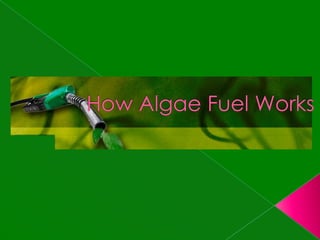
How algae fuel works
- 1. How Algae Fuel Works
- 2. Open Pond Growing The most natural method for growing algae that will be used to produce algae fuel is open-pond growing Open ponds are able to produce the greatest amount of algae in hot and sunny conditions Pros: Most natural and least invasive method Cons: Bad weather conditions slow growth Contamination from other living things in pond It is hard to keep the water at the temperature it must be for the algae to grow
- 3. Vertical Growth A quicker and more efficient method of producing algae is vertical growing Algae are put in clear plastic bags to allow sunlight on both sides Bags are put in tall piles and shielded from the rain Pros: Faster and more efficient than open-pond growth Algae won’t be contaminated Cons: It is hard to keep the water at the temperature it must be for the algae to grow
- 4. Closed-Tank Bioreactors For the fastest algae production, big, round barrels can grow algae indoors in closed-tank bioreactors The algae can be controlled into growing at the highest speed possible It is able to be harvested every day Pros: Large production of algae, which means more oil for biodiesel Good weather conditions for algae growth Plants can be built near energy plants in order to capture extra CO2 that would have polluted the air
- 5. Fermentation A modification to the closed-tank method of algae growth is called fermentation The algae are grown in closed containers and supplied with sugar to eat, which speeds their growth Pros: All weather and environmental conditions can be kept the same Algae can be grown anywhere in the world Cons: There are problems with finding enough sugar to use this process
- 6. Extracting Oil from Algae After producing the algae, a few different methods can be used to extract the lipids(oils) from the algae The product of this is Green Crude
- 7. Oil Press The easiest and most common process of extracting oil from algae is the oil press This method can remove up to 75% of the oil in the algae simply by pressing it This is the same technique an olive press uses
- 8. Hexane Solvent Method The 2-step process that removes up to 95% of oil from the algae is called the hexane solvent method First, the oil press method is used Next, the remaining algae is combined with methane, filtered and cleaned so that no chemical remains in the oil
- 9. Supercritical Fluids Method CO2 is used as the supercritical fluid to remove up to 100% of the oil from algae in the supercritical fluids method The CO2 is put under pressure and heated so that it is changed into a liquid, as well as a gas The CO2 is then combined with the algae, making it entirely turn into oil This is a less common method because there is extra labor and equipment need
- 10. Green Crude The Green Crude produced from algae can be processed in a refinery the same way conventional oil is It can be made into gasoline, diesel, and jet fuel, the main fuels needed in society
- 11. Transesterification Once the oil has been taken out, it is treated with fatty acid chains in a method called transesterification This process includes a catalyst (i.e. sodium hydroxide), which is combined with an alcohol (i.e. methanol) This will produce a biodiesel mixed with a glycerol (algae biodiesel fuel)
- 12. Cars Running on Algae Fuel The final product in the algae fuel process will be a Drop-in replacement fuel which is ASTM certified Gasoline, x26 Jet fuel
- 13. Turning Algae into Biodiesel
- 14. Why Algae? Source of crude oil. The regular crude oil we use today was originally formed from algae that bloomed millions of years ago Helps climate change. Absorbs about 13-14 kg of CO2 for every gallon of Green Crude grown Easy to grow. Algae can grow rapidly, especially in salt water in the desert.
- 15. REVIEW of Algae to Biofuel Process Algae (Green Crude) is grown from CO2 and sunlight Algae is harvested and the oil is removed Algae is refined (transesterification) in the same way as conventional oil Drop-in Gasoline, Jet Fuel, and Biodiesel is produced